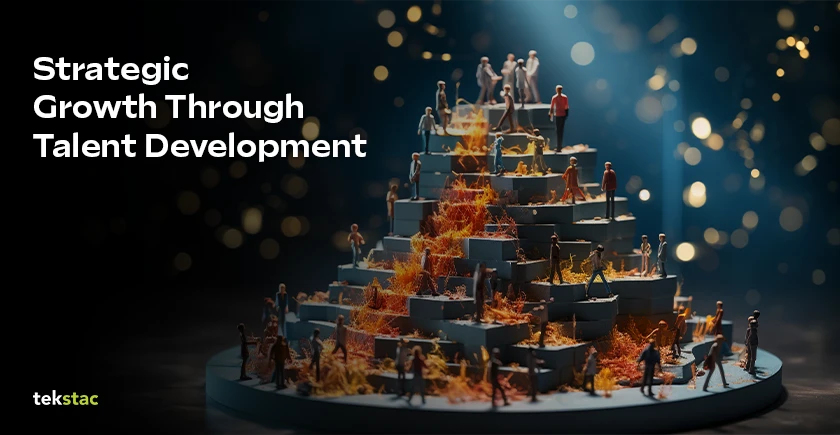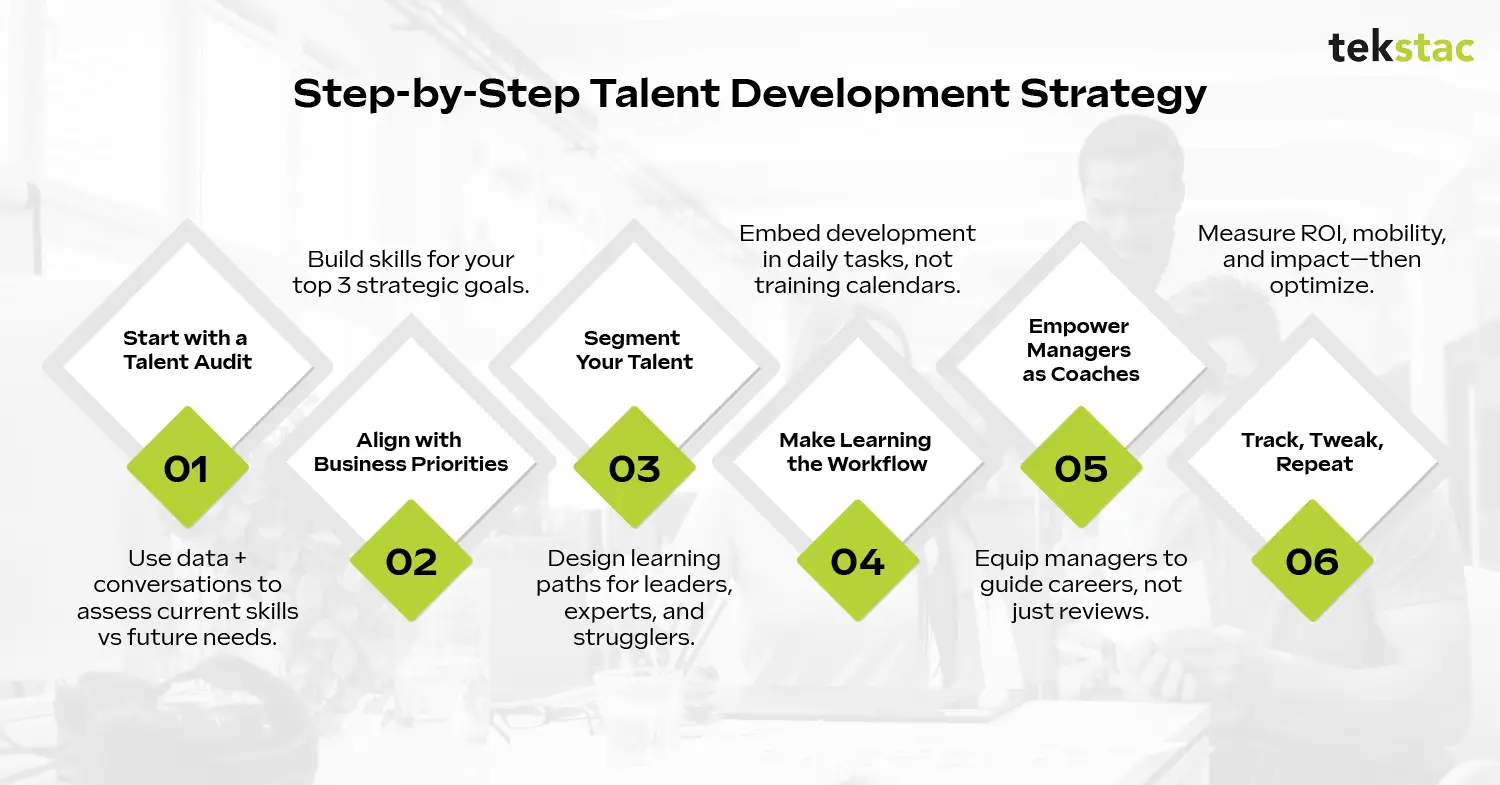Step-by-Step Guide to Building a High-Impact Talent Development Strategy

Why Most Organizations Lack a True Talent Development Strategy
Your business is only as adaptable as your people.
But right now, your people don’t have the skills your business needs.
49% of learning and talent leaders admit their executives are worried: employees can’t seem to deliver on the business strategy. Hence, skills alone won’t save you.
The most innovative companies are doing more than upskilling. They’re building internal ecosystems for growth, including coaching, leadership training, internal mobility, etc.
These “career development champions,” organizations that are pulling ahead on profitability, retention, and AI readiness through employee development, are 42% more likely to be Generative AI frontrunners, as per LinkedIn’s Workplace report.
And yet, only 36% of organizations qualify as champions. This means 64% of companies haven’t even started. There is no roadmap, no commitment—just scattered programs.
Let’s be honest—many organizations are still in the early stages of developing a strong talent development strategy. They don’t know what it looks like. This is exactly where we begin.
Why Talent Development Fails—and How Top Teams Succeed
Talent development strategies don’t look like assigning LinkedIn Learning courses every quarter. Even leadership training, on its own, isn’t a strategy. A true talent development strategy starts with a business problem, and ends with measurable impact. Career development champions connect employee development strategy to outcomes that actually matter:
- Strategic skills: future readiness
- Internal mobility: retention
- Leadership coaching: succession pipelines
- Career development: organizational performance
Now, here’s what the champions are doing differently:
1. They tie every workforce development plan to a business priority
These organizations don’t train for its own sake. The strategy builds AI fluency if the business is shifting to AI-powered tools. If a growth market opens, they groom internal talent to lead that charge.
2. They embed growth into roles
Career development should never be a one-time conversation. It’s designed into jobs, into culture, into how managers lead. Champions make growth visible, expected, and tracked. To truly grow employees, career development must be built into your performance management processes. That means development goals are set alongside business goals. Managers talk about growth in regular 1:1s. People know what skills they’re expected to build, and how that ties into the next role or project.
3. They open up internal mobility, and not just promotions
Employees need more than a new title; they need new challenges as well. The best organizations move talent laterally, vertically, and even across geographies. It’s less about hierarchy and more about exposure and stretch.
4. They fund learning with intent
Budgets are focused on critical roles, high-potential employees, and future skills. These companies treat talent development like product R&D.
5. They train managers to be career enablers
The biggest secret isn’t more content—it’s better managers. Champions are more likely to provide their managers with training to support career development because if they aren’t on board, your strategy won’t land.
Step-by-Step Process to Build a Talent Development Strategy
Most companies miss the mark by treating employee training and development as a series of disconnected programs instead of a cohesive strategy. They focus on content, assuming more training equals better performance, without aligning learning to business goals. This step-by-step process helps avoid this:
- Step 1: Conduct a Talent Audit to Identify Skill Gaps
- Step 2: Align Your Talent Development Strategy With Business Priorities
- Step 3: Segment Employees to Personalize Development Paths
- Step 4: Embed Continuous Learning Into Daily Workflows
- Step 5: Empower Managers to Drive Career Growth
- Step 6: Measure, Optimize, and Scale Your Talent Development Strategy

Step 1: Start With a Talent Audit, Not an Assumption
Skip this, and you’ll waste your budget.
Before jumping into upskilling, take stock of what you actually have. Conduct a talent audit to assess employees’ current skills, roles, and potential or your workforce against where the business is headed.
Start by asking:
- Which roles are business-critical for tomorrow—not just today?
- Where are we already bleeding skills due to attrition? (Hint: it’s not always technical roles. Strategic planning, project leadership, and sales management are silently vanishing.)
- What capabilities do we need to win in AI-led workflows, not survive them?
Pull in hard data (performance, exits, skill gaps), but don’t stop at dashboards. Run pulse conversations, interview managers, and look at internal mobility patterns. These don’t just help diagnose skill gaps but also in predicting future failure points.
Note: Champions are 49% more likely to use internal data to identify skill gaps and 48% more likely to build career paths with aligned skills and courses. Most organizations are flying blind. Don’t be one of them.
Step 2: Anchor Development to Business Priorities
Forget “training calendar” thinking! Instead, ask yourself about your organization’s three business bets this year. Then, think of the capabilities that these bets would demand. Build talent around these moves, be it expanding into new markets, implementing new tech, or overhauling operations. Your talent development strategy must read like a GTM plan rather than a policy document. That’s what gets executive buy-in as well.
Step 3: Segment Your Talent Like a Product Team
Your employees are not one audience. They’re high potentials, legacy SMEs, restless Gen Zs, and mid-level managers stuck in the middle. So why offer them the same workshops?
Prioritize your development paths:
- Emerging leaders: Mentorship, visibility, rotational projects
- Experts: Teaching roles, cross-functional impact, leadership-lite
- Laggards: Up-or-out clarity, not fake development tracks
Note: Champions offer 33% more tactics than non-champions: internal job postings, cross-functional gigs, career plans, gig-based work, and peer learning—all tailored.
Step 4: Build a Culture Where Learning Is How You Work (Not a Perk)
Most organizations still treat learning like a perk. But in top companies, learning is the workflow. They embed it to create a continuous learning culture through:
- Real-time feedback loops
- Performance reviews
- Internal project dashboards
- Job rotations and shadowing
- Even how they onboard tech and tools (microlearning vs manuals)
For instance, instead of sending new team leads to a generic leadership training, you could create a shadowing sprint where new leads spend their first month observing senior leaders in action, paired with weekly feedback reviews. This leads to faster ramp-up and fewer early missteps.
Note: Champions are 88% more likely to offer career-enhancing project work, and 32% more likely to deploy AI training.
Step 5: Turn Your Managers Into Career Enablers
Managers make or break development. Yet only 15% of employees say their manager helped them build a career plan in the last six months. This is because managers are underequipped. They’re drowning in operations and rarely trained to discuss growth.
What you can do:
- Train them on career coaching (not just compliance reviews)
- Give them the tools to spot stretch opportunities
- Reward managers who grow talent—not just those who deliver short-term KPIs
Step 6: Track, Tweak, Repeat
No company would leave a marketing campaign untracked, so why treat employee development like a static initiative? Make sure to track:
- Skill acquisition tied to business objectives
- Internal mobility rates
- Leadership pipeline health
- Learning engagement and application
This helps ensure if your talent development strategy is growing fast enough to match market shifts and if people are moving into critical roles, or out of the company.
From Initiative to Infrastructure: Making Talent Development Scalable
Workforce development plans shouldn’t depend on annual budgets or which HRBP’s leading the charge this year. If it does, your development plan is already fragile and may be forgotten by Q3.
Career development champions build infrastructure—systems that outlast people, roles, and restructures. Here’s how:
1. Make Career Development a Shared Accountability
Career development plans should be company-wide mandates. Executives define the bets, HR turns them into critical capabilities, and managers translate them into meaningful conversations about growth.
2. Operationalize Internal Mobility
Internal mobility starts with visibility. Employees must see what’s possible across teams, roles, and business units. Then comes normalization, where you reward managers who let talent move instead of hoarding it. Finally, automation and AI can match people’s skills with real opportunities.
3. Codify What Growth Looks Like
When asking employees to grow, organizations must clearly define what growth means.
- Create skills-based role maps
- Tie career moves to business impact
- Reward growth behaviors, not just business wins
Why Tekstac Is the Platform for Future-Ready Talent Development
If you build talent development strategies on spreadsheets, siloed platforms, and scattered learning content:
- You can’t see who’s learning what
- You can’t connect skill building to business impact
- And you definitely can’t scale what’s working across functions or levels
Organizations need a comprehensive talent development platform, like Tekstac, built for companies serious about capability building. It’s a full-stack skills development program trusted by IBM, PwC, Cognizant, Accenture, and many more to build a competent, future-ready workforce.
It directly plugs into your organizational infrastructure:
- Provides analytics to identify skill gaps across roles, departments, and levels
- 500+ curated learning paths across data, cloud AI, and security.
- Provides the ability to host your internal content or integrate third-party resources
- Hands-on labs, self-paced modules, and embedded assessments make development part of the workflow
- Progress dashboards let managers see exactly how their teams are growing and where they’re stuck
- Adapts to different personas and business priorities, be it onboarding new grads or upskilling senior engineers
- Measures with real-time dashboards, AI-powered proctoring, and audit-ready reports.
A development initiative on its own won’t solve the bigger problem. Without a solid system in place, processes will inevitably fall apart. An infrastructure, or system, ensures every initiative is connected, repeatable, and scalable. And that’s precisely how Tekstac integrates learning into your broader business strategy.
Ready to change how your team learns, grows, and performs? Start here
FAQs on Talent Development Strategy
1. Why is Talent Development Important in 2026?
In 2026, talent development is critical as AI and automation rapidly reshape roles. Organizations that continuously upskill their workforce stay competitive, retain top talent, and adapt faster to changing business needs.
2. What is the difference between HR strategy and talent strategy?
An HR strategy focuses on managing people operations—like payroll, policies, and compliance. A talent strategy goes deeper, aligning skills, development, and succession planning directly with business goals and future growth.
3. How to develop a talent acquisition strategy?
Start by defining your ideal talent profile, then align recruitment with your long-term skill needs. Use data, employer branding, and talent pipelines to attract, evaluate, and retain high-performing employees.





